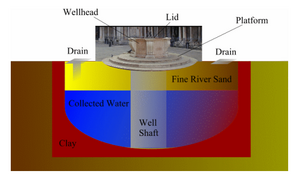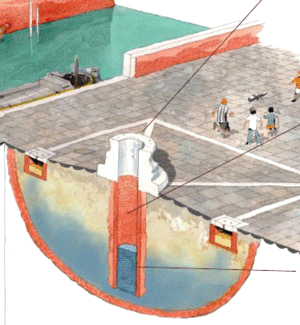Wellhead: Difference between revisions
No edit summary |
No edit summary |
||
| Line 14: | Line 14: | ||
==Body== | ==Body== | ||
Most wellheads are composed exclusively of Istria stone, Red Verona marble, or White Verona marble. | |||
Istria stone is the most common material, it is a type of limestone that has a gray-green or yellowish color. Lengthy exposure to the atmosphere causes the stone to obtain a whitish appearance through a process called “whitewashing.” Unfortunately, this also makes Istria stone a prime candidate for exfoliation. | |||
Verona marble is a sedimentary rock composed of organic limestone and fossils. It has either a reddish or whitish color depending on the carbon compounds it contains. | |||
[[File:pozzi.png|left|thumb|alt=pozzi|cross sectional well diagram from Insula SpA]] | [[File:pozzi.png|left|thumb|alt=pozzi|cross sectional well diagram from Insula SpA]] | ||
Revision as of 20:07, 9 December 2014
This page contains information about a typical Venetian wellhead.
A wellhead (Vera da Pozzo in Italian) is the only exposed part of the well where people used to pull the water out from. The wellhead appears as a circular basin with a lid above ground. Today, they only serve as decoration purpose, see Public Art

History
Wellheads, known locally as “vera da pozzo”, cap underground wells that stored and filtered rain water in Venice up until 1884, when a modern water supply system was established. The term ‘wellhead’ has been in use since as early as the eleventh century and has many different variations: anello, corona, sponda, cinta, parapetto, spalletta or bocca di pozzo apart from the aforementioned vera da pozzo. Reference Rizzi book)
As a centerpiece of many public squares in Venice, “They were always at the center of socialization and interactivity among Venetians” (Wainwright et al., 2000, pg 16). Wellheads often featured inscriptions and carvings of saints or family crests. The artistic and structural design of each wellhead is indicative of the art period it was built in. (Huse, 1990)
Even though these wellheads appear as ornamental works of art, they were also innovative in their practicality. The wellheads were designed to prevent animals, debris, or floodwater from polluting the clean water source stored below (Wainwright et al., 2000, pg 16).
Structure
A typical wellhead has a platform, the main body and lid. Some platforms are made up of up to three steps. This is the only exposed part of the well. (Thomollari, 2004)
Body
Most wellheads are composed exclusively of Istria stone, Red Verona marble, or White Verona marble.
Istria stone is the most common material, it is a type of limestone that has a gray-green or yellowish color. Lengthy exposure to the atmosphere causes the stone to obtain a whitish appearance through a process called “whitewashing.” Unfortunately, this also makes Istria stone a prime candidate for exfoliation.
Verona marble is a sedimentary rock composed of organic limestone and fossils. It has either a reddish or whitish color depending on the carbon compounds it contains.

Lid
Drain
Well Shaft
While functioning as Venetians main water supply, the actual well shaft that extended from the wellhead to the cistern was made from bricks and lined with a layer of impermeable clay[2].
Cistern
The cisterns were made with large stones and then lined with impermeable clay that prevented the fresh water from leaking out and more importantly prevented salt water from leaking in and contaminating the water supply[3].
Current Water Supply
Venice is now supplied with water from the mainland, traveling underground through pipes from the commune Trebaseleghe which is filled by 120 artisan wells[4].
See also
References
- ↑ Blackwell, Lewis et al. Preserving Venetian Wellheads. 2000. Pg 21
- ↑ Insula spa and Matteo Alemanno, Venice Preservation and Urban Maintenance( Venice, Italy: Grafiche Veneziane)
- ↑ Insula spa and Matteo Alemanno, Venice Preservation and Urban Maintenance( Venice, Italy: Grafiche Veneziane)
- ↑ Venice. The 1911 Classic Encyclepedia. October 21, 2006. http://www.1911encyclopedia.org/Venice
Bibliography
NULL